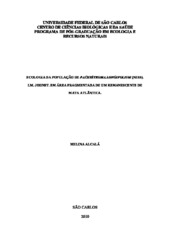Mostrar el registro sencillo del ítem
Ecologia da população de Pachystroma longifolium (Ness). I.M. Johnst. em área fragmentada de um remanescente de mata atlântica
| dc.contributor.author | Alcalá, Melina | |
| dc.date.accessioned | 2016-06-02T19:31:50Z | |
| dc.date.available | 2010-05-19 | |
| dc.date.available | 2016-06-02T19:31:50Z | |
| dc.date.issued | 2010-03-05 | |
| dc.identifier.citation | ALCALÁ, Melina. Ecologia da população de Pachystroma longifolium (Ness). I.M. Johnst. em área fragmentada de um remanescente de mata atlântica. 2010. 62 f. Dissertação (Mestrado em Ciências Biológicas) - Universidade Federal de São Carlos, São Carlos, 2010. | por |
| dc.identifier.uri | https://repositorio.ufscar.br/handle/ufscar/1987 | |
| dc.description.abstract | This study investigated the structure of spatial and ontogenetic stages of the species Pachystroma longifolium (Euphorbiaceae) in semideciduous forest in São Carlos, identifying and describing the post-germinative ontogenetic stages that characterize the development of the species, besides investigate whether the patterns allometric vary within and/or between ontogenetics stages. The spatial pattern was obtained using the aggregation index with the objective to check there are differences in spatial distribution pattern between ontogenetic stages and if these are determined by the preference of niches facilitators or arising from dispersion autochoric. In 1 ha were found 202 individuals and 4 ontogenetic stages were obtained: juvenile, immature, adult vegetative and reproductive adult. No seedlings were found in the plots and senile, which may be related to micro-environmental variation of the area or characteristics of the species. The branching pattern shown followed the Massart's architectural model, which is characteristic of species well adapted to low light conditions. All ontogenetic stages showed significant differences in height and diameter, indicating that they facing different environmental conditions and there is a great way allometric for each stage or group of stages, allowing for the best trade-off between stem diameter and height of plant. The population shows a patchy distribution, and the juveniles were those with the largest index of aggregation. Could not detect an effect of percentage of soil moisture on the distribution and density of individuals. As for the effect of percentage of canopy in the dry and rainy seasons, the correlation was positive and significant for the immature stage and the total of individuals in the area. The clustered pattern found for the population may be related both to autochoric dispersal strategies, as with the characteristics of the species. | eng |
| dc.description.sponsorship | Financiadora de Estudos e Projetos | |
| dc.format | application/pdf | por |
| dc.language | por | por |
| dc.publisher | Universidade Federal de São Carlos | por |
| dc.rights | Acesso Aberto | por |
| dc.subject | Ecologia vegetal | por |
| dc.subject | Ontogenia | por |
| dc.subject | Alometria | por |
| dc.subject | Distribuição espacial | por |
| dc.subject | Relação alométrica | por |
| dc.subject | Ontogeny | eng |
| dc.subject | Allometry | eng |
| dc.subject | Spatial pattern | eng |
| dc.title | Ecologia da população de Pachystroma longifolium (Ness). I.M. Johnst. em área fragmentada de um remanescente de mata atlântica | por |
| dc.type | Dissertação | por |
| dc.contributor.advisor1 | Matos, Dalva Maria da Silva | |
| dc.contributor.advisor1Lattes | http://lattes.cnpq.br/4728734263109138 | por |
| dc.description.resumo | O presente estudo investigou a estrutura de estádios ontogenéticos e espacial da espécie Pachystroma longifolium (Euphorbiaceae) na floresta estacional semidecídua, em São Carlos, identificando e descrevendo os estádios ontogenéticos pós-germinativos que caracterizam o desenvolvimento da espécie, além de investigar se os padrões alométricos variam dentro e/ou entre os estádios ontogenéticos. O padrão espacial foi obtido utilizando o Indíce de agregação com o objetivo de verificar se há diferenças no padrão de distribuição espacial entre os estádios ontogenéticos e se estas são determinadas pela preferência de nichos facilitadores ou decorrentes da dispersão autocórica. Em 1,0 ha amostrados encontramos 202 indivíduos distribuídos em 4 estádios ontogenéticos: juvenil, imaturo, adulto vegetativo e adulto reprodutivo. Não encontramos plântulas e senil nas parcelas, o que pode estar relacionado com a variação microambiental da área ou com características intrínsecas da espécie. O padrão de ramificação apresentado é próprio do modelo arquitetural de Massart, que é característico de espécies bem adaptadas às condições de pouca luz. Todos os estádios ontogenéticos apresentaram diferenças significativas em altura e diâmetro, indicando que estes enfrentam condições ambientais distintas havendo uma forma alométrica ótima para cada estádio ou conjunto de estádios. A população apresenta uma distribuição agregada, sendo que os juvenis foram os que apresentaram o maior Índice de agregação. Não foi possível detectar um efeito da porcentagem de umidade do solo sobre a distribuição e densidade dos indivíduos. Quanto ao efeito da porcentagem de cobertura de dossel na estação seca e chuvosa, a correlação foi positiva e significativa para o estádio imaturo e para o número total de indivíduos presentes na área. O padrão de distribuição agregado encontrado para a população pode estar relacionado tanto com estratégias de dispersão autocórica, quanto com características intrínsecas da espécie. | por |
| dc.publisher.country | BR | por |
| dc.publisher.initials | UFSCar | por |
| dc.publisher.program | Programa de Pós-Graduação em Ecologia e Recursos Naturais - PPGERN | por |
| dc.subject.cnpq | CIENCIAS BIOLOGICAS::ECOLOGIA | por |
| dc.contributor.authorlattes | http://lattes.cnpq.br/7782163752432829 | por |
